LC-MS Based Platform Simplifies Access to Metabolomics for Peroxisomal Disorders
Abstract
1. Introduction
2. Results
2.1. 143 Metabolites Analyzed from Plasma Samples
2.2. ZSS Patients Show Decreased Acyl-Ether-Linked Phospholipids
2.3. VLCFA-Linked Membrane Lipid Levels Are Increased in Both Peroxisomal Disorders, but Overall Sphingomyelin Levels Are Only Decreased in ZSS Patients
2.4. Peroxisomal Disorders Show Disease Specific Clustering
2.5. X-ALD Patients Can Be Separated from Controls, but Show a Less Stringent Metabotype
2.6. D-Bifunctional Protein Deficiency Type III Patients Show Alterations of Peroxisomal Markers
2.7. Summary of Results
3. Discussion
4. Materials and Methods
4.1. Study Cohort
4.2. Metabolomics Analysis
4.3. Denotation of the Lipid Classes
4.4. Statistical Procedures
Author Contributions
Funding
Institutional Review Board Statement
Informed Consent Statement
Data Availability Statement
Acknowledgments
Conflicts of Interest
Appendix A
| Mean Serum Concentration (µM) | SEM (µM) | |||||
|---|---|---|---|---|---|---|
| X-ALD | Control | ZSS | X-ALD | Control | ZSS | |
| PC ae C30:0 | 0.51 | 0.32 | 0.28 | 0.04 | 0.03 | 0.04 |
| PC ae C30:1 | 0.11 | 0.07 | 0.08 | 0.02 | 0.01 | 0.01 |
| PC ae C30:2 | 0.36 | 0.16 | 0.11 | 0.03 | 0.02 | 0.02 |
| PC ae C32:1 | 1.71 | 1.58 | 0.40 | 0.09 | 0.12 | 0.06 |
| PC ae C32:2 | 0.54 | 0.40 | 0.16 | 0.02 | 0.03 | 0.02 |
| PC ae C34:0 | 1.12 | 1.04 | 0.91 | 0.05 | 0.14 | 0.12 |
| PC ae C34:1 | 6.33 | 6.32 | 2.08 | 0.33 | 0.56 | 0.32 |
| PC ae C34:2 | 6.94 | 5.52 | 1.04 | 0.43 | 0.38 | 0.20 |
| PC ae C34:3 | 4.23 | 3.66 | 0.60 | 0.26 | 0.32 | 0.14 |
| PC ae C36:0 | 1.29 | 0.67 | 1.05 | 0.10 | 0.07 | 0.14 |
| PC ae C36:1 | 65.55 | 24.81 | 30.94 | 5.74 | 2.99 | 6.59 |
| PC ae C36:2 | 19.58 | 8.30 | 6.12 | 1.55 | 0.63 | 1.16 |
| PC ae C36:3 | 4.13 | 3.80 | 0.75 | 0.19 | 0.28 | 0.12 |
| PC ae C36:4 | 7.76 | 9.28 | 0.67 | 0.70 | 1.04 | 0.20 |
| PC ae C36:5 | 4.44 | 5.64 | 0.53 | 0.34 | 0.67 | 0.13 |
| PC ae C38:0 | 1.69 | 0.80 | 0.43 | 0.12 | 0.06 | 0.06 |
| PC ae C38:1 | 27.12 | 7.58 | 18.46 | 2.67 | 1.72 | 4.69 |
| PC ae C38:2 | 22.05 | 6.94 | 11.71 | 2.32 | 1.39 | 2.60 |
| PC ae C38:3 | 21.39 | 10.59 | 7.20 | 1.43 | 1.41 | 1.16 |
| PC ae C38:4 | 8.51 | 8.36 | 1.63 | 0.35 | 0.71 | 0.30 |
| PC ae C38:5 | 5.81 | 8.58 | 0.59 | 0.46 | 0.95 | 0.14 |
| PC ae C38:6 | 1.90 | 2.72 | 0.25 | 0.15 | 0.30 | 0.04 |
| PC ae C40:1 | 3.83 | 1.34 | 1.00 | 0.27 | 0.17 | 0.20 |
| PC ae C40:2 | 6.12 | 3.28 | 2.88 | 0.38 | 0.40 | 0.42 |
| PC ae C40:3 | 10.15 | 5.39 | 4.19 | 0.62 | 0.92 | 0.62 |
| PC ae C40:4 | 5.30 | 3.38 | 1.61 | 0.25 | 0.38 | 0.32 |
| PC ae C40:5 | 6.09 | 4.73 | 1.30 | 0.43 | 0.43 | 0.21 |
| PC ae C40:6 | 1.95 | 2.34 | 0.32 | 0.12 | 0.21 | 0.05 |
| PC ae C42:0 | 1.63 | 0.66 | 0.72 | 0.09 | 0.05 | 0.08 |
| PC ae C42:1 | 2.84 | 0.82 | 0.79 | 0.17 | 0.14 | 0.15 |
| PC ae C42:2 | 2.23 | 0.82 | 0.56 | 0.13 | 0.11 | 0.09 |
| PC ae C42:3 | 2.37 | 1.01 | 0.67 | 0.15 | 0.13 | 0.12 |
| PC ae C42:4 | 1.65 | 1.03 | 0.48 | 0.08 | 0.09 | 0.08 |
| PC ae C42:5 | 2.69 | 2.24 | 0.98 | 0.13 | 0.16 | 0.09 |
| PC ae C44:3 | 0.81 | 0.30 | 0.26 | 0.05 | 0.05 | 0.05 |
| PC ae C44:4 | 0.80 | 0.43 | 0.23 | 0.04 | 0.03 | 0.03 |
| PC ae C44:5 | 1.19 | 1.07 | 0.22 | 0.06 | 0.08 | 0.03 |
| PC ae C44:6 | 0.74 | 0.68 | 0.22 | 0.04 | 0.05 | 0.03 |
| C16:0-Diacetal (Ratio to 16:0 FA) | C18:0-Diacetal (Ratio to 18:0 FA) | PC ae 36:4 (µM) | ||||
|---|---|---|---|---|---|---|
| Patient | Subject | Reference Range | Subject | Reference Range | Subject | 95% Confidence |
| ZSS_1 | 5.2 | 6.8–11.9 | 11.2 | 10.6–24.9 | 0.801 | 7.24–11.32 |
| ZSS_2 | 9.0 | 6.8–11.9 | 20.4 | 10.6–24.9 | 0.619 | 7.24–11.32 |
| ZSS_3 | 6.9 | 6.8–11.9 | 15.4 | 10.6–24.9 | 3.69 | 7.24–11.32 |
| ZSS_4 | 7.3 | 6.8–11.9 | 18.0 | 10.6–24.9 | 1.25 | 7.24–11.32 |
| Mean Serum Concentration (µM) | SEM (µM) | |||||
|---|---|---|---|---|---|---|
| X-ALD | Control | ZSS | X-ALD | Control | ZSS | |
| SM C16:0 | 113.98 | 131.31 | 62.73 | 4.44 | 14.44 | 5.68 |
| SM C16:1 | 15.72 | 15.41 | 6.61 | 0.57 | 1.12 | 0.63 |
| SM C18:0 | 14.70 | 29.81 | 7.93 | 0.72 | 4.22 | 1.19 |
| SM C18:1 | 8.35 | 13.57 | 4.23 | 0.44 | 1.34 | 0.75 |
| SM C20:2 | 0.48 | 0.56 | 0.19 | 0.04 | 0.13 | 0.03 |
| SM C24:0 | 33.97 | 28.31 | 13.39 | 1.46 | 2.15 | 1.28 |
| SM C24:1 | 59.63 | 68.97 | 30.85 | 2.79 | 6.11 | 3.14 |
| SM C26:0 | 0.84 | 0.28 | 0.81 | 0.07 | 0.03 | 0.14 |
| SM C26:1 | 1.27 | 0.56 | 1.45 | 0.09 | 0.06 | 0.29 |
| Mean Serum Concentration (µM) | SEM (µM) | |||||
|---|---|---|---|---|---|---|
| X-ALD | Control | ZSS | X-ALD | Control | ZSS | |
| lysoPC C16:0 | 205.33 | 189.41 | 120.50 | 11.87 | 14.50 | 15.53 |
| lysoPC C16:1 | 5.03 | 3.15 | 2.09 | 0.37 | 0.29 | 0.23 |
| lysoPC C17:0 | 4.16 | 4.49 | 1.80 | 0.30 | 0.46 | 0.34 |
| lysoPC C18:0 | 65.24 | 78.80 | 43.94 | 3.78 | 9.05 | 7.19 |
| lysoPC C18:1 | 37.07 | 36.46 | 24.78 | 1.84 | 4.98 | 3.50 |
| lysoPC C18:2 | 38.34 | 21.52 | 16.68 | 2.00 | 2.50 | 2.78 |
| lysoPC C20:3 | 2.90 | 3.46 | 1.82 | 0.15 | 1.03 | 0.26 |
| lysoPC C20:4 | 7.06 | 6.79 | 3.26 | 0.32 | 1.23 | 0.46 |
| lysoPC C24:0 | 0.99 | 0.34 | 0.69 | 0.06 | 0.04 | 0.09 |
| lysoPC C26:0 | 2.12 | 0.54 | 1.29 | 0.15 | 0.11 | 0.16 |
| lysoPC C26:1 | 0.39 | 0.19 | 0.43 | 0.02 | 0.03 | 0.05 |
| lysoPC C28:0 | 1.61 | 0.56 | 0.75 | 0.14 | 0.10 | 0.13 |
| lysoPC C28:1 | 1.11 | 0.49 | 0.48 | 0.08 | 0.07 | 0.07 |
| C16:0-Diacetal (Ratio to 16:0 FA) | C18:0-Diacetal (Ratio to 18:0 FA) | PC ae 36:4 (µM) | ||||
|---|---|---|---|---|---|---|
| Patient | Subject | Reference Range | Subject | Reference Range | Subject | 95% Confidence |
| DBIII_1 | 4.3 | 6.8–11.9 | 6.3 | 10.6–24.9 | 5.32 | 7.24–11.32 |
| DBIII_2 | 12.8 | 6.8–11.9 | 15.0 | 10.6–24.9 | 2.82 | 7.24–11.32 |

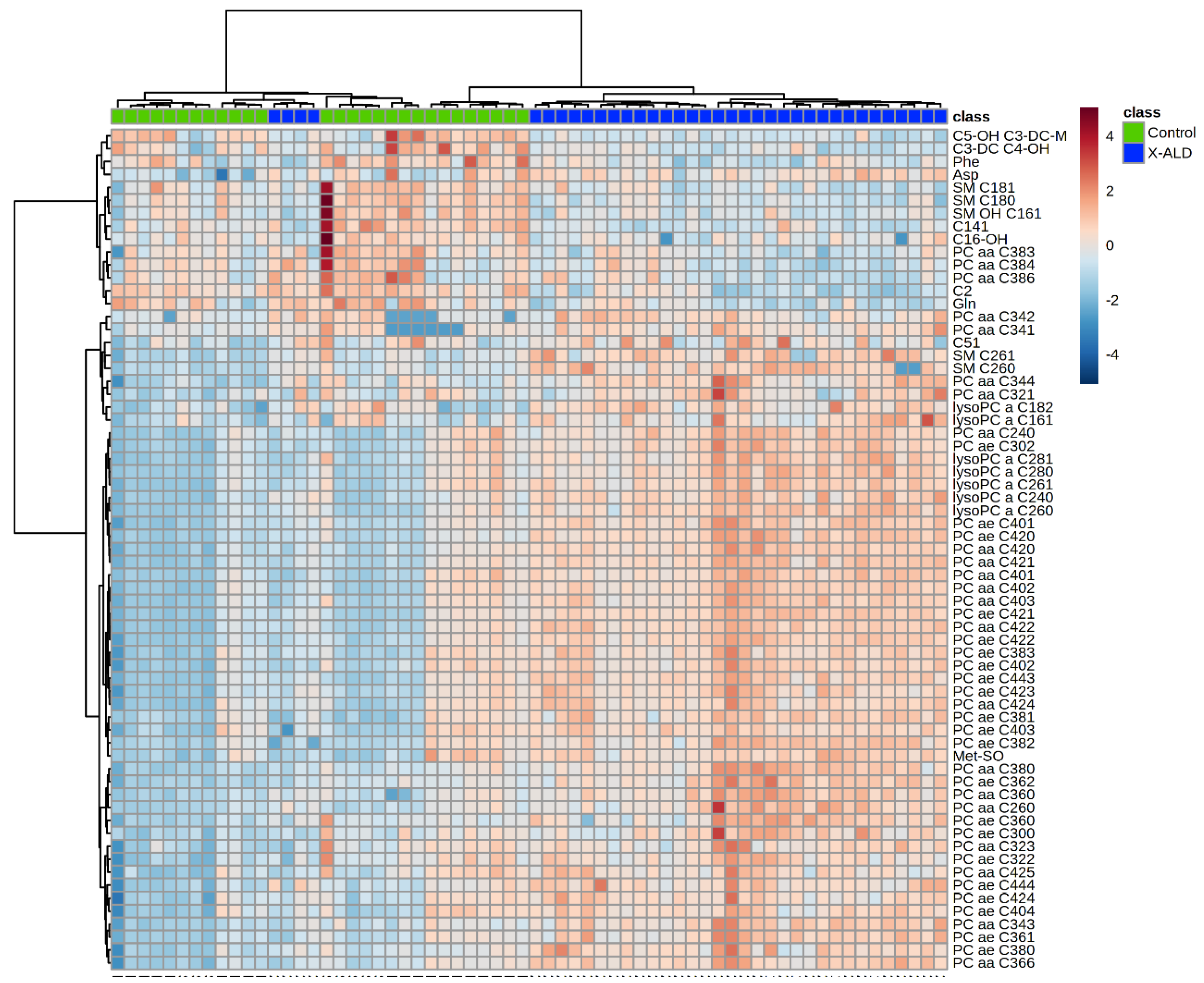
References
- Sargsyan, Y.; Thoms, S. Staying in Healthy Contact: How Peroxisomes Interact with Other Cell Organelles. Trends Mol. Med. 2019, 26. [Google Scholar] [CrossRef] [PubMed]
- Wanders, R.J.A.; Poll-The, B.T. Role of Peroxisomes in Human Lipid Metabolism and Its Importance for Neurological Development. Neurosci. Lett. 2017, 637, 11–17. [Google Scholar] [CrossRef] [PubMed]
- Wanders, R.J.A.; Vaz, F.M.; Waterham, H.R.; Ferdinandusse, S. Fatty Acid Oxidation in Peroxisomes: Enzymology, Metabolic Crosstalk with Other Organelles and Peroxisomal Disorders. Adv. Exp. Med. Biol. 2020, 1299, 55–70. [Google Scholar] [CrossRef] [PubMed]
- Waterham, H.R.; Ferdinandusse, S.; Wanders, R.J.A. Human Disorders of Peroxisome Metabolism and Biogenesis. Biochim. Biophys. Acta BBA Mol. Cell Res. 2016, 1863, 922–933. [Google Scholar] [CrossRef] [PubMed]
- Verhoeven, N.M.; Wanders, R.J.A.; Poll-The, B.T.; Saudubray, J.-M.; Jakobs, C. The Metabolism of Phytanic Acid and Pristanic Acid in Man: A Review. J. Inherit. Metab. Dis. 1998, 21, 697–728. [Google Scholar] [CrossRef] [PubMed]
- Wanders, R.J.A.; Komen, J.; Ferdinandusse, S. Phytanic Acid Metabolism in Health and Disease. Biochim. Biophys. Acta BBA Mol. Cell Biol. Lipids 2011, 1811, 498–507. [Google Scholar] [CrossRef]
- Kelley, R.I. The Cerebrohepatorenal Syndrome of Zellweger, Morphologic and Metabolic Aspects. Am. J. Med Genet. 1983, 16, 503–517. [Google Scholar] [CrossRef]
- Klouwer, F.C.C.; Berendse, K.; Ferdinandusse, S.; Wanders, R.J.A.; Engelen, M.; Poll-The, B.T. Zellweger Spectrum Disorders: Clinical Overview and Management Approach. Orphanet J. Rare Dis. 2015, 10. [Google Scholar] [CrossRef]
- Braverman, N.E.; Raymond, G.V.; Rizzo, W.B.; Moser, A.B.; Wilkinson, M.E.; Stone, E.M.; Steinberg, S.J.; Wangler, M.F.; Rush, E.T.; Hacia, J.G.; et al. Peroxisome Biogenesis Disorders in the Zellweger Spectrum: An Overview of Current Diagnosis, Clinical Manifestations, and Treatment Guidelines. Mol. Genet. Metab. 2016, 117, 313–321. [Google Scholar] [CrossRef]
- Takemoto, Y.; Suzuki, Y.; Horibe, R.; Shimozawa, N.; Wanders, R.J.A.; Kondo, N. Gas Chromatography/Mass Spectrometry Analysis of Very Long Chain Fatty Acids, Docosahexaenoic Acid, Phytanic Acid and Plasmalogen for the Screening of Peroxisomal Disorders. Brain Dev. 2003, 25, 481–487. [Google Scholar] [CrossRef]
- Vreken, P.; van Lint, A.E.M.; Bootsma, A.H.; Overmars, H.; Wanders, R.J.A.; van Gennip, A.H. Rapid Stable Isotope Dilution Analysis of Very-Long-Chain Fatty Acids, Pristanic Acid and Phytanic Acid Using Gas Chromatography-Electron Impact Mass Spectrometry. J. Chromatogr. B Biomed. Sci. Appl. 1998, 713, 281–287. [Google Scholar] [CrossRef]
- Bacino, C.A.; Chao, Y.-H.; Seto, E.; Lotze, T.; Xia, F.; Jones, R.O.; Moser, A.; Wangler, M.F. A Homozygous Mutation in PEX16 Identified by Whole-Exome Sequencing Ending a Diagnostic Odyssey. Mol. Genet. Metab. Rep. 2015, 5, 15–18. [Google Scholar] [CrossRef] [PubMed]
- Ratbi, I.; Falkenberg, K.D.; Sommen, M.; Al-Sheqaih, N.; Guaoua, S.; Vandeweyer, G.; Urquhart, J.E.; Chandler, K.E.; Williams, S.G.; Roberts, N.A.; et al. Heimler Syndrome Is Caused by Hypomorphic Mutations in the Peroxisome-Biogenesis Genes PEX1 and PEX6. Am. J. Hum. Genet. 2015, 97, 535–545. [Google Scholar] [CrossRef]
- Wangler, M.F.; Hubert, L.; Donti, T.R.; Ventura, M.J.; Miller, M.J.; Braverman, N.; Gawron, K.; Bose, M.; Moser, A.B.; Jones, R.O.; et al. A Metabolomic Map of Zellweger Spectrum Disorders Reveals Novel Disease Biomarkers. Genet. Med. 2018. [Google Scholar] [CrossRef]
- Herzog, K.; Pras-Raves, M.L.; Ferdinandusse, S.; Vervaart, M.A.T.; Luyf, A.C.M.; van Kampen, A.H.C.; Wanders, R.J.A.; Waterham, H.R.; Vaz, F.M. Plasma Lipidomics as a Diagnostic Tool for Peroxisomal Disorders. J. Inherit. Metab. Dis. 2018, 41, 489–498. [Google Scholar] [CrossRef] [PubMed]
- Herzog, K.; Pras-Raves, M.L.; Vervaart, M.A.T.; Luyf, A.C.M.; van Kampen, A.H.C.; Wanders, R.J.A.; Waterham, H.R.; Vaz, F.M. Lipidomic Analysis of Fibroblasts from Zellweger Spectrum Disorder Patients Identifies Disease-Specific Phospholipid Ratios. J. Lipid Res. 2016, 57, 1447–1454. [Google Scholar] [CrossRef] [PubMed]
- Herzog, K.; Pras-Raves, M.L.; Ferdinandusse, S.; Vervaart, M.A.T.; Luyf, A.C.M.; van Kampen, A.H.C.; Wanders, R.J.A.; Waterham, H.R.; Vaz, F.M. Functional Characterisation of Peroxisomal β-Oxidation Disorders in Fibroblasts Using Lipidomics. J. Inherit. Metab. Dis. 2018, 41, 479–487. [Google Scholar] [CrossRef] [PubMed]
- Siskos, A.P.; Jain, P.; Römisch-Margl, W.; Bennett, M.; Achaintre, D.; Asad, Y.; Marney, L.; Richardson, L.; Koulman, A.; Griffin, J.L.; et al. Inter-Laboratory Reproducibility of a Targeted Metabolomics Platform for Analysis of Human Serum and Plasma. Anal. Chem. 2017, 89, 656–665. [Google Scholar] [CrossRef] [PubMed]
- Björkhem, I.; Sisfontes, L.; Boström, B.; Kase, B.F.; Blomstrand, R. Simple Diagnosis of the Zellweger Syndrome by Gas-Liquid Chromatography of Dimethylacetals. J. Lipid Res. 1986, 27, 786–791. [Google Scholar] [CrossRef]
- Hubbard, W.C.; Moser, A.B.; Liu, A.C.; Jones, R.O.; Steinberg, S.J.; Lorey, F.; Panny, S.R.; Vogt, R.F.; Macaya, D.; Turgeon, C.T.; et al. Newborn Screening for X-Linked Adrenoleukodystrophy (X-ALD): Validation of a Combined Liquid Chromatography-Tandem Mass Spectrometric (LC-MS/MS) Method. Mol. Genet. Metab. 2009, 97, 212–220. [Google Scholar] [CrossRef]
- Heymans, H.S.A.; Schutgens, R.B.H.; Tan, R.; van den Bosch, H.; Borst, P. Severe Plasmalogen Deficiency in Tissues of Infants without Peroxisomes (Zellweger Syndrome). Nature 1983, 306, 69–70. [Google Scholar] [CrossRef]
- Hajra, A.K.; Das, A.K. Lipid Biosynthesis in Peroxisomesa. Ann. N. Y. Acad. Sci. 1996, 804, 129–141. [Google Scholar] [CrossRef] [PubMed]
- Wanders, R.J.A. Metabolic and Molecular Basis of Peroxisomal Disorders: A Review. Am. J. Med. Genet. Part A 2004, 126A, 355–375. [Google Scholar] [CrossRef] [PubMed]
- Malheiro, A.R.; da Silva, T.F.; Brites, P. Plasmalogens and Fatty Alcohols in Rhizomelic Chondrodysplasia Punctata and Sjögren-Larsson Syndrome. J. Inherit. Metab. Dis. 2015, 38, 111–121. [Google Scholar] [CrossRef] [PubMed]
- Lands, W.E.M. Metabolism of Glycerolipides: A Comparison of Lecithin and Triglyceride Synthesis. J. Biol. Chem. 1958, 231, 883–888. [Google Scholar] [CrossRef]
- Vogel, B.H.; Bradley, S.E.; Adams, D.J.; D’Aco, K.; Erbe, R.W.; Fong, C.; Iglesias, A.; Kronn, D.; Levy, P.; Morrissey, M.; et al. Newborn Screening for X-Linked Adrenoleukodystrophy in New York State: Diagnostic Protocol, Surveillance Protocol and Treatment Guidelines. Mol. Genet. Metab. 2015, 114, 599–603. [Google Scholar] [CrossRef] [PubMed]
- Natarajan, A.; Christopher, R.; Netravathi, M.; Bhat, M.D.; Chandra, S.R. Flow Injection Ionization-Tandem Mass Spectrometry-Based Estimation of a Panel of Lysophosphatidylcholines in Dried Blood Spots for Screening of X-Linked Adrenoleukodystrophy. Clin. Chim. Acta 2019, 495, 167–173. [Google Scholar] [CrossRef]
- Liebisch, G.; Vizcaíno, J.A.; Köfeler, H.; Trötzmüller, M.; Griffiths, W.J.; Schmitz, G.; Spener, F.; Wakelam, M.J.O. Shorthand Notation for Lipid Structures Derived from Mass Spectrometry. J. Lipid Res. 2013, 54, 1523–1530. [Google Scholar] [CrossRef]
- Chong, J.; Wishart, D.S.; Xia, J. Using MetaboAnalyst 4.0 for Comprehensive and Integrative Metabolomics Data Analysis. Curr. Protoc. Bioinform. 2019, 68, e86. [Google Scholar] [CrossRef]
- Hunter, J.D. Matplotlib: A 2D Graphics Environment. Comput. Sci. Eng. 2007, 9, 90–95. [Google Scholar] [CrossRef]
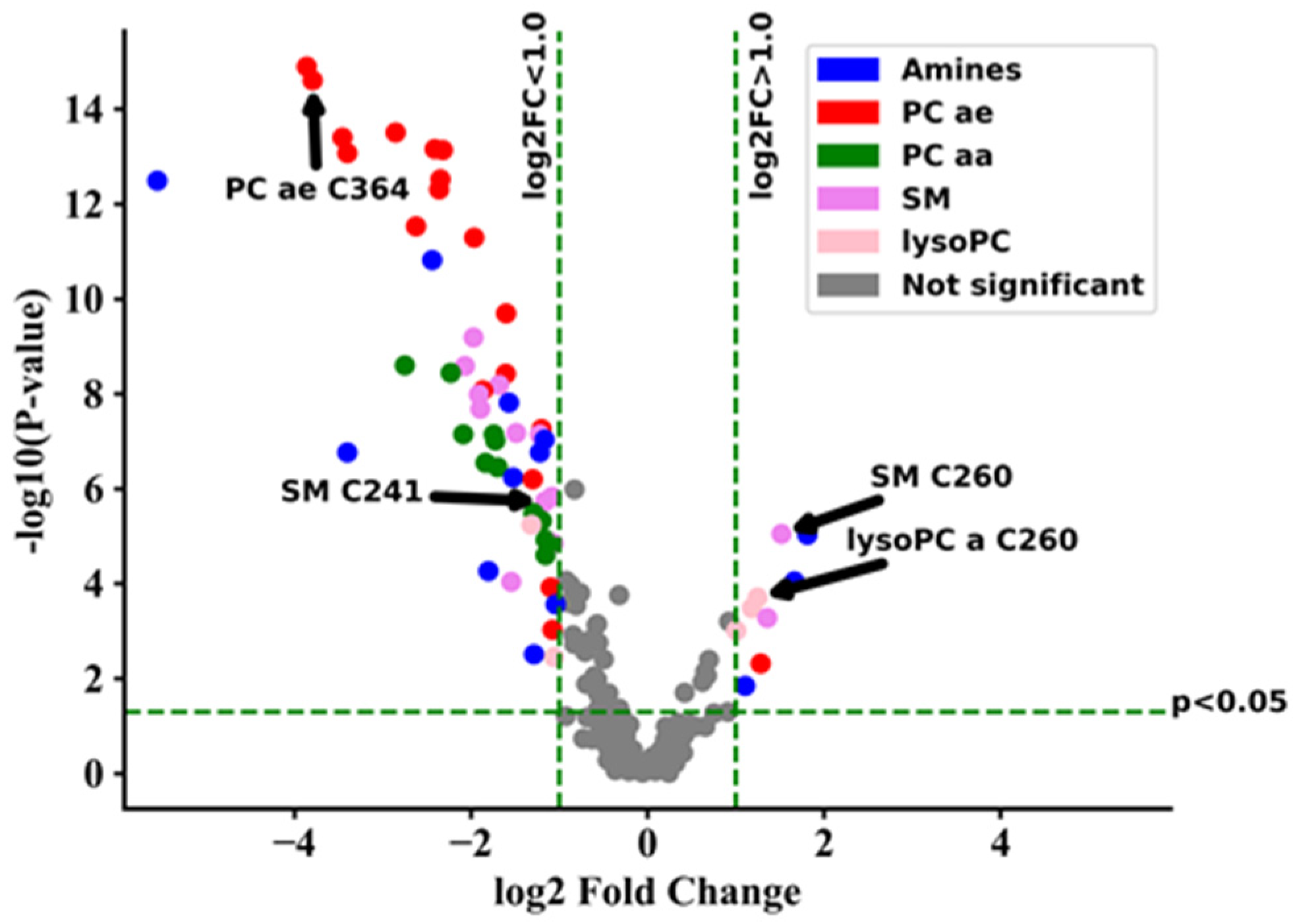
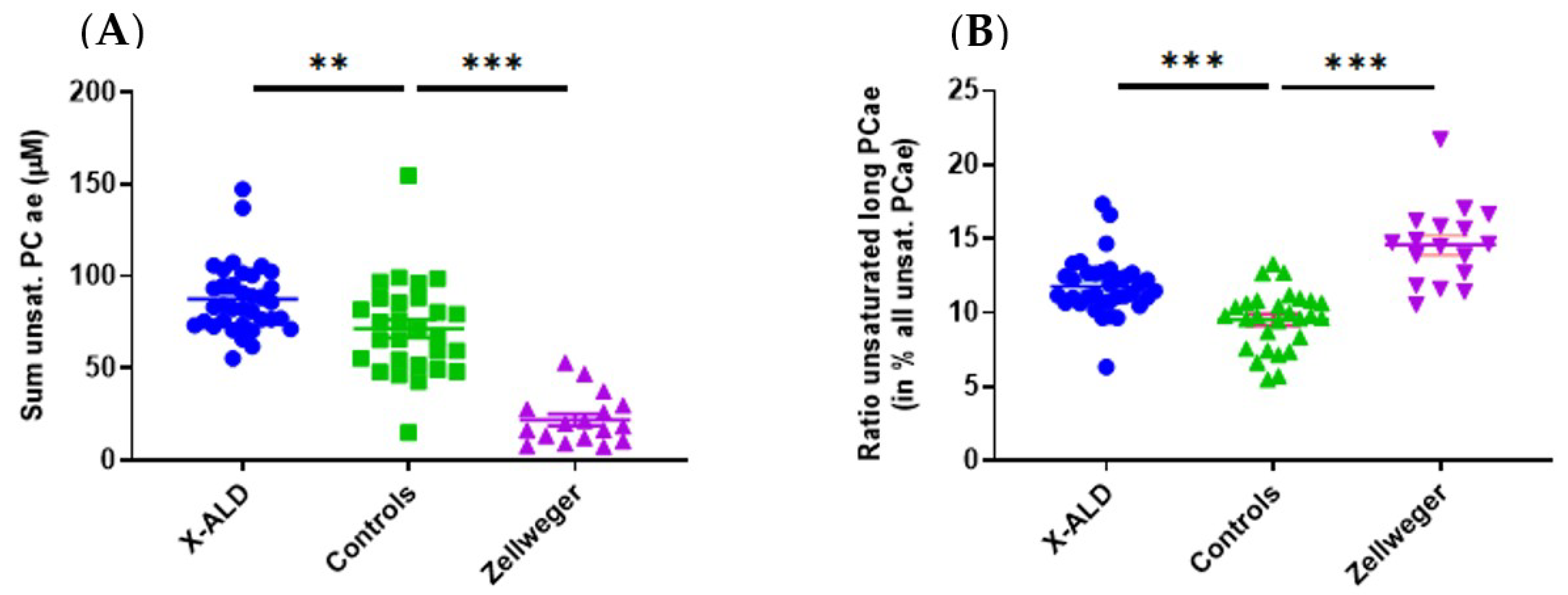
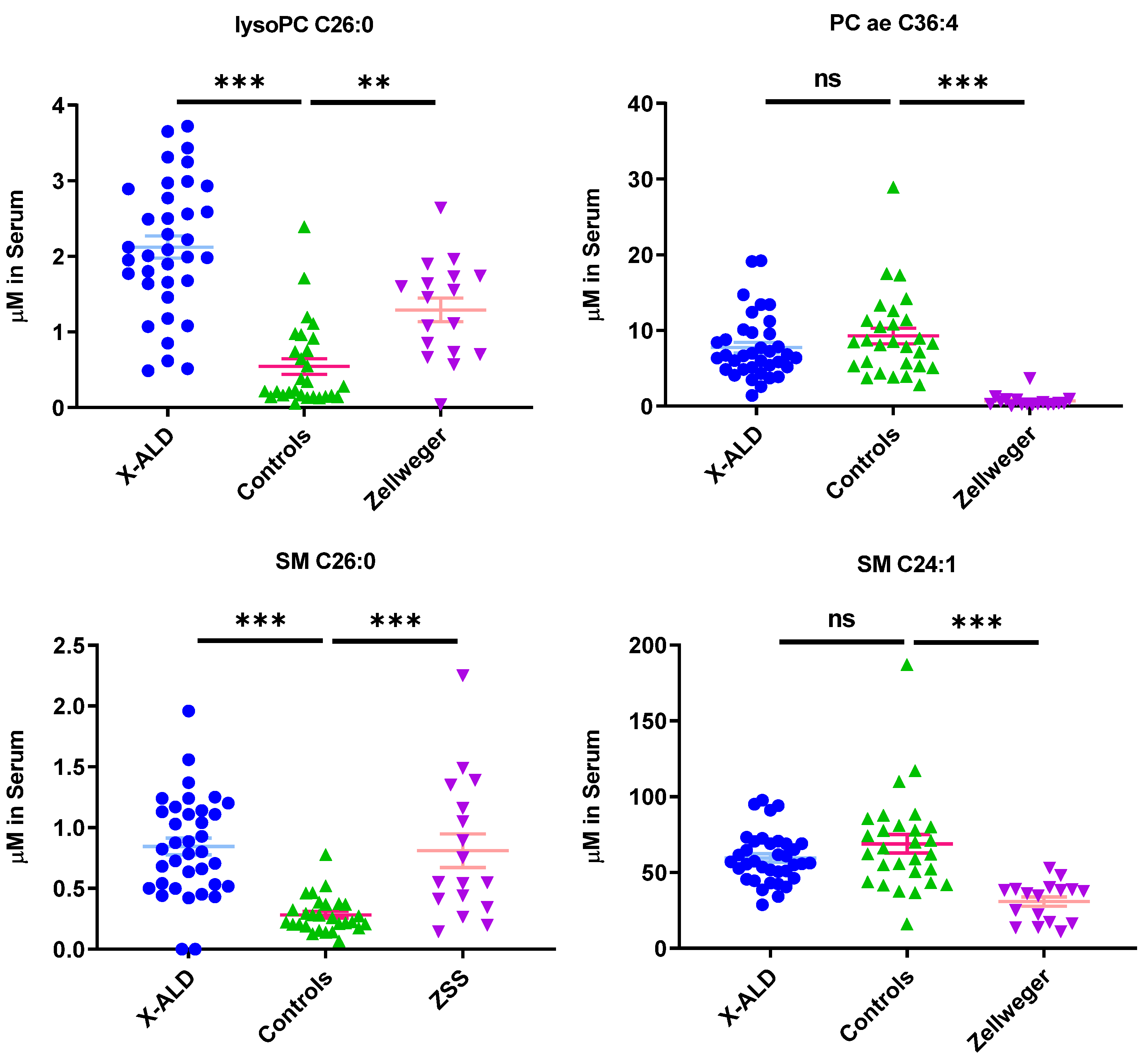
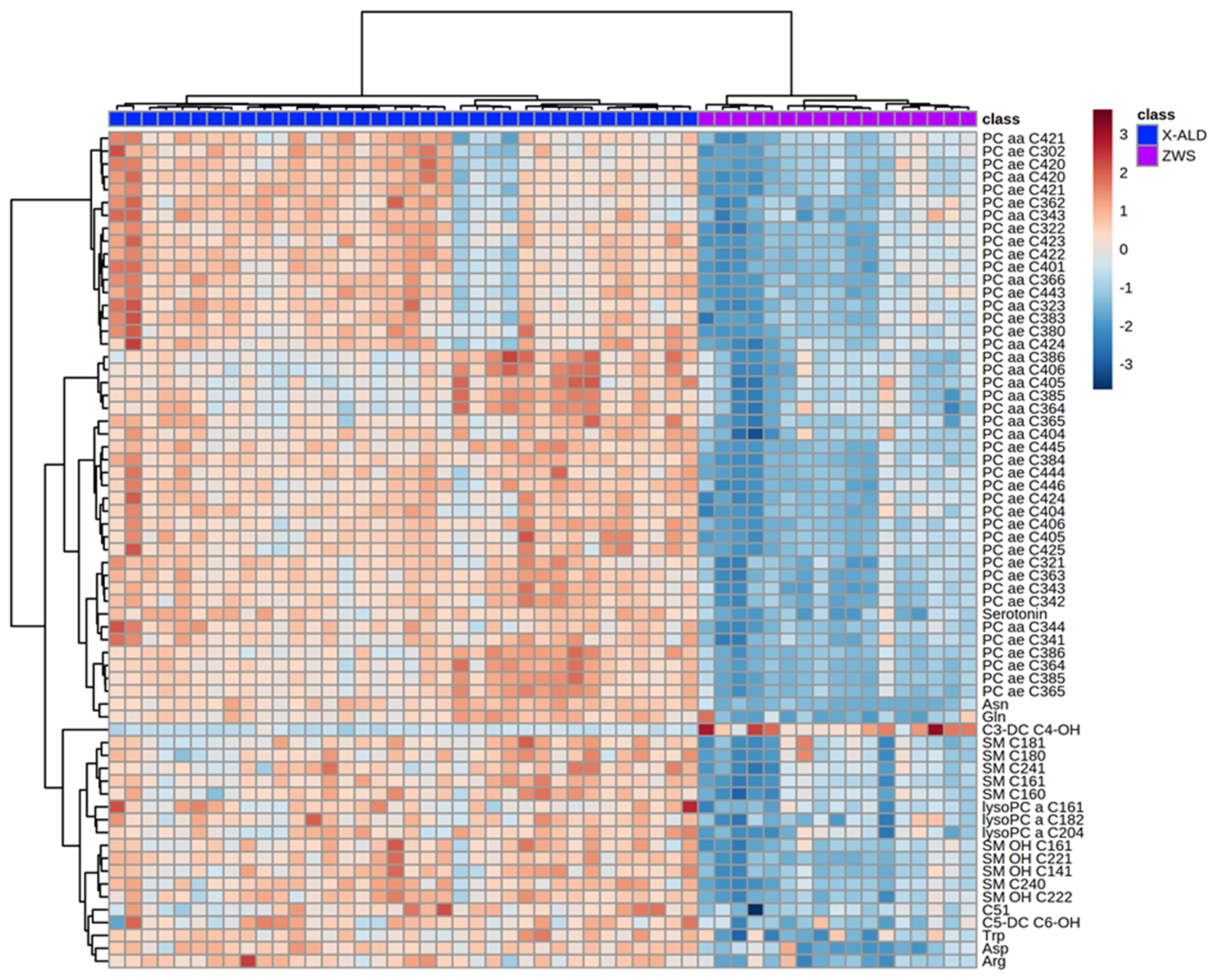
Publisher’s Note: MDPI stays neutral with regard to jurisdictional claims in published maps and institutional affiliations. |
© 2021 by the authors. Licensee MDPI, Basel, Switzerland. This article is an open access article distributed under the terms and conditions of the Creative Commons Attribution (CC BY) license (https://creativecommons.org/licenses/by/4.0/).
Share and Cite
Klemp, H.G.; Kettwig, M.; Streit, F.; Gärtner, J.; Rosewich, H.; Krätzner, R. LC-MS Based Platform Simplifies Access to Metabolomics for Peroxisomal Disorders. Metabolites 2021, 11, 347. https://doi.org/10.3390/metabo11060347
Klemp HG, Kettwig M, Streit F, Gärtner J, Rosewich H, Krätzner R. LC-MS Based Platform Simplifies Access to Metabolomics for Peroxisomal Disorders. Metabolites. 2021; 11(6):347. https://doi.org/10.3390/metabo11060347
Chicago/Turabian StyleKlemp, Henry Gerd, Matthias Kettwig, Frank Streit, Jutta Gärtner, Hendrik Rosewich, and Ralph Krätzner. 2021. "LC-MS Based Platform Simplifies Access to Metabolomics for Peroxisomal Disorders" Metabolites 11, no. 6: 347. https://doi.org/10.3390/metabo11060347
APA StyleKlemp, H. G., Kettwig, M., Streit, F., Gärtner, J., Rosewich, H., & Krätzner, R. (2021). LC-MS Based Platform Simplifies Access to Metabolomics for Peroxisomal Disorders. Metabolites, 11(6), 347. https://doi.org/10.3390/metabo11060347






